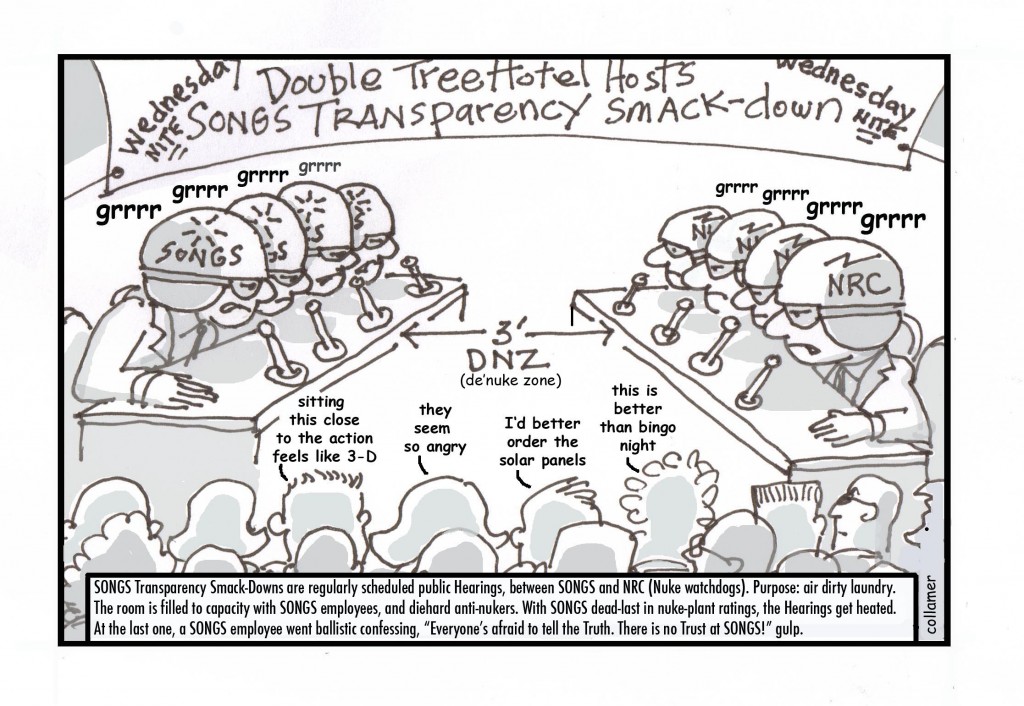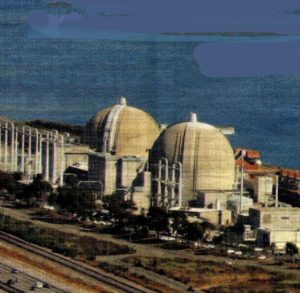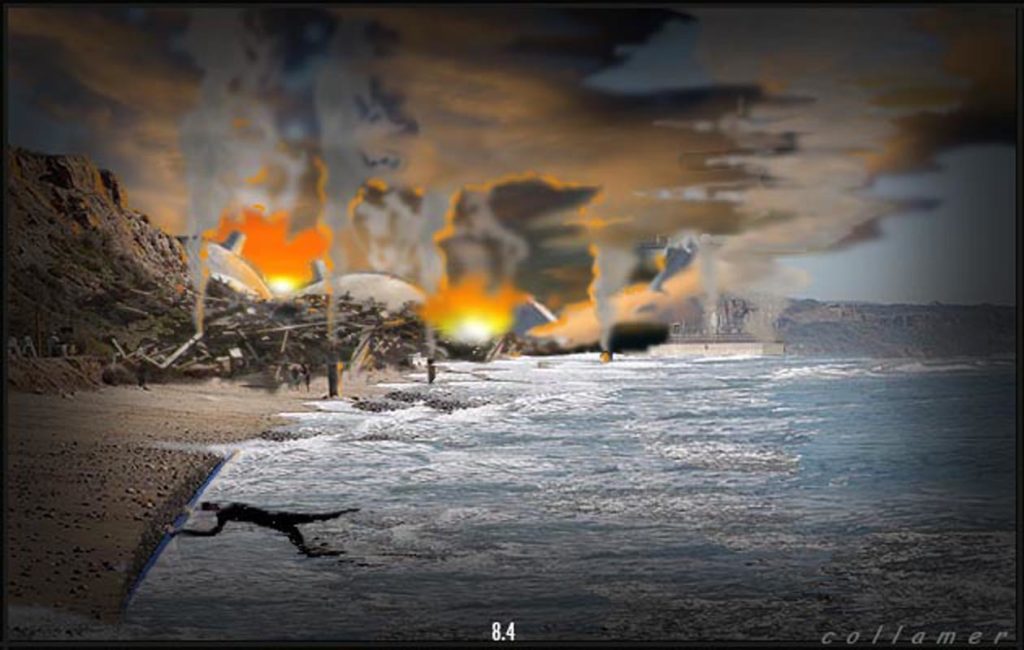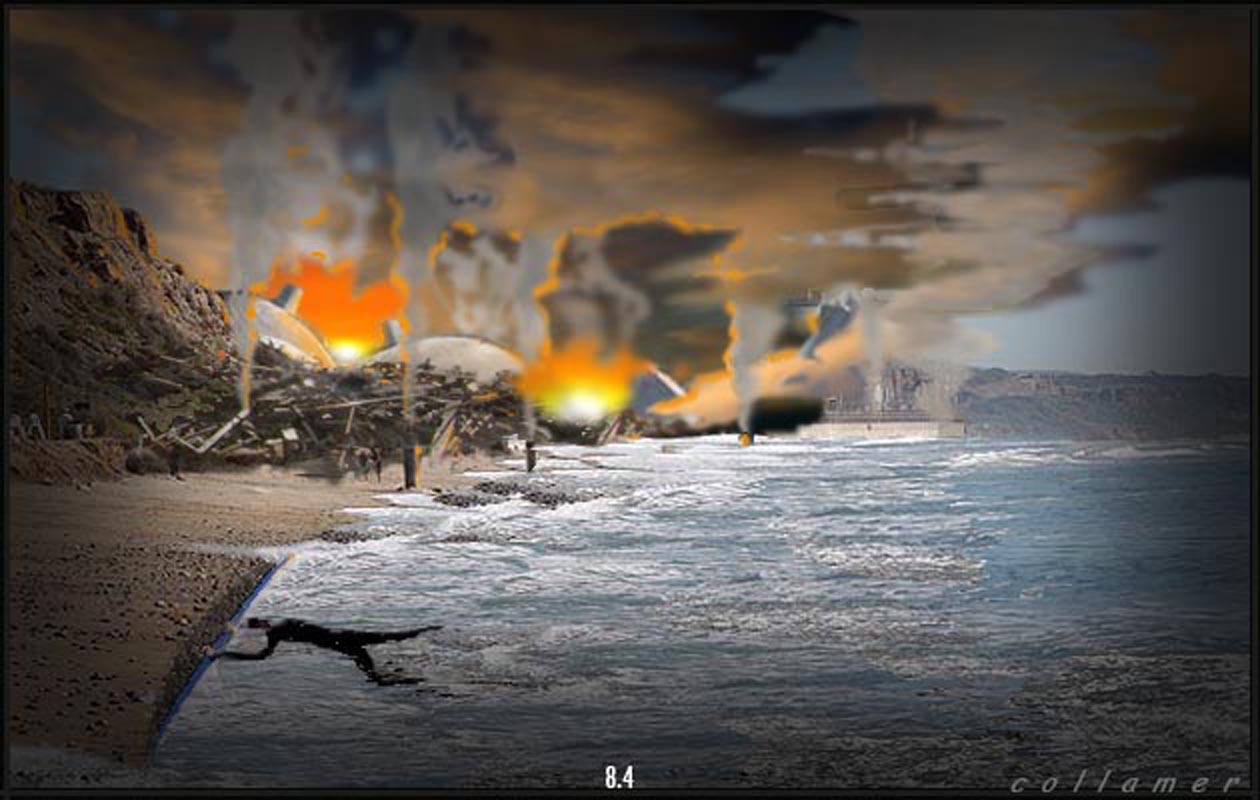Typically, in death-defying pursuits, the more dangerous the task, the more understated the definition of fatal human error. At the now-shuttered San Onofre Nuclear Generating Station, deadly goofs = Hiccups = The Scariest Workplace in the USA.


Reading this will upset a bunch of folks living near the San Onofre Nuclear Generating Station, called SONGS, between Orange and San Diego Counties, California. Because as far as I can tell, the truth percolating inside SONGS nuke plant ain’t getting out.
SONGS / Edison employs 3,000. Not all from the local area. Some permanent. Some ‘contract’ players. Moving from power-plant contract, to power-plant contract. Statewide, nationwide, probably internationally. And, not necessarily to nuke facilities.
Most of what happens at SONGS, in maintenance, upkeep, revitalization, infrastructure improvements, also applies to non-nuke power plants. Nukes make up maybe 20% of our power generation nationwide. Welders, concrete specialists, plumbers, carpenters, electricians, you name it, are in there servicing SONGS. Trying to keep the cranky ol’gal from hiccupping. Goof-ups at SONGS are labeled “Hiccups.”
STORY: Nuclear Regulatory Smackdown at San Onofre


Typically, in death-defying pursuits: jet pilots, astronauts, sky diving, mountain climbing, wild animal trainers, sword swallowers, snake charmers, special-ops military, nuke workers – the more dangerous the task, the more understated the definition of fatal human error.
At SONGS, goofs = Hiccups. Author Tom Wolfe introduced us to deadly understatements with “Screw the Pooch.” A jet pilot inadvertently buys the farm in Wolfe’s epic The Right Stuff. No biggie the death thing. It’s the known cost of doing risky business.
In military-think, potential death is basic to the task. Marginalized to be sure. Avoid at all costs. Keep losses small / militarily insignificant. When worst happens, get back to the drawing boards to restrategize. In Iraq, that became “The Surge.” In WWII it meant dropping the “Big One.” Which was actually two Big Ones, ending that war. WWII military minds calculated dropping “the Big One” twice, saved lives.
Ghastly calculations, the business of flow-charting war: guesstimating potential, rationalized fatalities. Expendable human life. A sobering reality, as people in high places, think-tanks, military brain-trusts, political leaders, and corporations put pluses and minus on our existence.
When we dropped the two Big Ones, labeled Little Boy / Hiroshima – Aug. 6, 1945 and Fat Man / Nagasaki – Aug. 9, 1945 (our nuclear awakening in two acts), no one knew for certain the degree of devastation our two “big ones” would cause, slipping from their bomb bays, diving head first into unholy infamy.
Lesson learned? Well, no one’s dropped one since. Pray Oh Lord, they never will. SNF (scary nuke fact): Nuclear Power Plants harbor that same awesome power in varying degrees. It’s why insurance companies won’t insure them. If a severe hiccup burps up, like happened in Chernobyl Russia, loss of life and property is incalculable. And everlasting.
STORY: Disaster Roulette: Earthquakes and Nukes at San Onofre


Loose-nukes: the unholy-gift that keeps on giving. Chernobyl today, 24-years after its meltdown, radiates its invisible death knell 24-7. A full time on-site crew, man the crumbling site, monitoring its hellish leak. San Clemente, a deserted city, once 55,000 strong, decays nearby. SNF: Nuclear contamination cannot be contained once its terrible genie escapes the bottle.
SNF: one “spent” fuel rod, mere inches in length – past its generating prime, is relieved of duty by entombing it in a steel and concrete coffin many feet thick – will hold its radiant charge for 5,000 to 50,000 years, depending which nuke’pert you ask.
SNF: no one really understands the impacts. Like the two-nukes dropped on Japan, no one knew till after, what we’d created. Minutes after Japan’s nuclear incineration, the stunned world became an expert.
Generating nuclear power is mathematical guesswork, based on best-guess scientific assumptions. It’s why nuke-plants are over engineered steel-and-concrete behemoths. To protect surrounding humanity from its minuscule radiating death-rods, should a hiccup jump its perimeter.
Smaller than mom’s rolling pin. Able to devastate entire counties, or worse, depending on prevailing winds should the bad-beastie escape. And the beast can release in a thousand different angry variables. And now, who could imagine Japan, touted as technologically superior worldwide and having learned from experience, would produce the out of control, radiating nuclear meltdown / human screw-up we now watch in stunned silence on TV? For the indescribably unfortunate Japanese citizen suffering it point blank, with nowhere to run, and nowhere to hide, stuck in yet another man-made radiating grim reality, waiting for the other shoe to fall — is the scariest, soon to be deadliest workplace on earth.
But Japan’s evolving nuclear tragedy in no way excuses SONGS’ troubled nuke-plant fireworks, as SONGS holds down solid last place in US-nukes’ unsatisfactory safety record, or makes a SONGS’ similar conclusion any less frightening. Because all SONGS needs, is the same perfect storm to hit California’s coastline.
Geologists warn, SONGS sits atop the same ticking time bomb ring-of-fire tectonic underpinnings as does Japan. A Pacific Rim necklace (includes the Indian Ocean) extending north up the western coastlines of South and North America, east across the Aleutians to Asia, flowing south along Asia’s western perimeter to Australia. Japan’s weak link in the Pacific Rim’s infamous ring-of-fire necklace mirrors a SONGS potential.
Seismologist agree, the USA’s west coast is overdue for “our” next big-one. Japan is the example. SONGS is our neighboring reality.
There are 104 nuke plants in the USA. Most radiate east of the Mississippi. California has four. Two are operational. SONGS is one of the two, with the worst safety record of all 104, right here in San Clemente.
Did I mention SONGS is old? Primitive by today’s nuke-plant standards. But Edison keeps bandaging its 50’s era design, constructed in the 60’s. Original plan: decommission by 2013. Relentless government lobbying has pushed SONGS end-time to 2020 to maximize profitability before mothballing. But just maybe, Edison wringing every last drop of stockholder dividend from its tired beast, long past her prime, is why morale inside SONGS’ grumbling belly of 3,000 caregivers grows more corrosive by the day. Multiple management changes in as many years have fixed nothing.
A new plant CEO is up to bat. He sounds as good as the last one. And the one before. And? SNF: a growling gut, causes hiccups. Hiccups of the nuclear kind no one on Earth can afford. And especially San Clemente.
SONGS score of 10 – 10 being worst, begs this question: as SONGS good neighbor, how expendable are we?
Follow WilderUtopia on Facebook…










Jerry,
I think it would be best if you at least made an attempt to educate yourself somewhat with regards to nuclear power generation in the USA prior to writing an article about the subject. My personal guess is that you are on of those disgruntled SONGS employees that feel they should do everything they can to damage the plant’s reputation.
At the very least, it would be great if you and your ilk would refrain from comparing the plants here with Chernobyl. Chernobyl was a vastly different design which we simply do not use. Nuclear Power in the US has a better safety record than nearly any other comparable industry. I certainly hope that not too many people stumble upon your little island of misinformation.
Three of my family members work(s)/worked at SONGS. Two of them are dead from cancer. The third has had two tumors removed. One on on the face, the other the pancreas. Other than them, none in my family has ever contracted cancer. We have a history of heart disease, not cancer. Do you think there could be a link?
Most you you who work at SONGS have to believe you are safe. It is a mental health necessity to believe that the work environment is safe. It is not. I was always struck by the number of times my family members would talk about this person or that person contracting cancer.
How much safer is SONGS design as compared to say…Fukishima? I think that comparison would be more relevant. And that is precisely what the author compared SONGS to. Your response is typical of a SONGs worker who has to believe you are safe. The term for it is Group Think.
A response to the SONGS “Scariest Workplace in America” opinion piece from a “Nuke Worker,” is unprintable as submitted.
Typical of all credible blogs and or websites, “comments” are carefully scrutinized for unnecessary volatility, slanderous attack, and or unwarranted personal remarks regarding race, sex, gender, or religiosity. Keeping debate on a balanced and fair-minded playing field, free from hate speech or personal attack in today’s public arena, be it online, or on air, or in the public place, has never been more critical, when discussing topical issues of the day. WilderUtopia.com and the author, Jerry Collamer, are happy to respond to the substance of the submitted comments and welcome a healthy, spirited debate.
Following is a version of the comment, edited, with responses thereafter. Mr. Collamer’s general response was: “Many thanks for your detailed response to WilderUtopia.com’s nuke-scare posting titled: SONGS – Scariest Work Place in America.
“You are obviously well versed in nuclear science. Though, the “science” of nuclear energy production was not the gist of the aforementioned “dangerous workplace” description at SONGS’ aged nuclear facility.”
Commenter: You are horribly misinformed, sir. Here’s a list of just a few of the things you got wrong:
Collamer: You might be right.
Maybe I should stop attending the semi-annual NRC / SONGS public hearings held here over the past 9-years. Every meeting is scarier than the last one.
Besides, the nukes-industry likes it best when the public sleeps.
Commenter: 1.) I see you hinted at the fact that SONGS does not employ only people from the surrounding community. While I’m completely in favor of hiring employees from the nearby communities of this and all businesses, it is a little unreasonable to ask a company like Edison to hire some 3,000 highly skilled workers to fully staff an advanced facility all from one area. Contract employment happens in every sector of business, this is not solely applicable to the nuclear industry. Get over it. The safety culture of the nuclear industry states that there’s a right person for every job in a facility–and that “right person” is the one who possesses the skills necessary to do the safest and most efficient job in the plant. Hence, if that person doesn’t fit the bill, the utility will find someone who does. SNF: This is simple economics.
Collamer: Think I said: “San Clemente has lots of SONGS employees living here.”
They are all good and valuable citizens. Some are my good friends.
I just wish they weren’t working at such a dangerous ‘old’ plant.
One employee describes SONGS hiring practices:
“SONGS hires 2000 people, to look at 2000 valves.”
They are all skilled professionals.
That’s not my point.
Commenter: 2.) Saying that “Nuclear Power Plants harbor that same awesome power in varying degrees [as a nuclear bomb]” is about the same as saying that a single bullet in a handgun possesses the same killing power of the entire U.S. Armed Forces in all its wars. IT DOESN’T MAKE SENSE! Nuclear weapons using uranium as the fission source are enriched to 99.999% U235, whereas nuclear power fuel is enriched from 3.5%-5.5% U235. Furthermore, in a nuclear pressure vessel (the “pot” where the uranium boils water), there are multiple passive and active features to ensure that a LOCA (loss of coolant accident) event cannot occur. Also, fissioning of atoms in a nuclear bomb uses inward pressure to cause the fission reaction to push inward, thus creating a criticality localized in the center of the bomb. Reactors are designed to prevent this AT ALL COSTS through low enrichment levels, appropriate fuel fabrication specs, and meticulous in-core geometry of fission events. SNF: A reactor vessel cannot create a mushroom cloud.
Collamer: According to NRC lingo: the deadly cloud / release, is called a “plume.”
SONGS warns: should a nuclear “plume” arise – pray for prevailing winds to carry it away from San Clemente.
That could mean west, out to sea.
Or east over Camp Pendleton.
Or south, over the city of Oceanside.
Or maybe it stalls-out, “pluming” over San Clemente.
Our city administers pills to protect one’s thyroid in case of “plume.”
Orange County, and cities within the 10-mile “Immediate Danger Zone,” lecture on safety precautions in case of “plume.” They educate us on evacuation routes and plans. Freeway closures. Home survival kits. Duct taped windows. Keeping reserve supplies of bottled water on hand, nonperishable food items etc, in case the city “locks down.”
We’re instructed to have special emergency-band radios at home.
Every month there are SONGS emergency siren test-warnings throughout the city.
The “science” of nuclear power generation is not why we have a countywide SONGS preparedness system in place – and regularly tested.
Rather, that a surprise ‘chink’ / ‘hiccup’ (their words), somewhere within
SONGS plumbing network, combined with human error, fails.
Nuclear science is not NRC’s, or SONGS concern here.
Everyone is comfortable with the science.
Rather it’s the aged, troubled facility, and ongoing labor-management distrust of one another. The debates are heated, and unsettling.
Commenter: 3.) The catastrophe at Chernobyl is without a doubt one of the worst disasters to befall ANY industry, and will always be a skeleton in the nuclear industry’s closet. However, Chernobyl happened for reasons that were predominantly attributable to the Soviet Government’s nearing collapse, improper action by operators in the control room, a lack of a safety culture around the entire Soviet nuclear program, and to horrid design flaws in the Soviet RBMK reactor. The RBMK (Chernobyl reactor) has individual pressure tubes, whereas a U.S. nuclear reactor has all its fuel centrally located in a containment vessel. In the U.S., our reactors have pressure vessels/containment vessels that allow for safety features to be applied to a singular, contained fuel area. The RBMK at Chernobyl did not have this feature and thus, a fire occurred and burned a hole in the roof of the reactor building. SNF: Nuclear power is the world’s largest provider of CO2-free energy.
Collamer: I know about Chernobyl.
Thankfully, we don’t have that faulty design.
What we do have is a plant designed to be mothballed in 2013 that Edison has lobbied to have extend to 2020 and beyond.
No one at SONGS argues the point – SONGS is old technology.
Designed in the late 50’s, constructed throughout the 60’s, it was finally fired up in the early 70’s. If we were talking a cotton-mill instead of a nuclear generating plant, “old” would not be a problem.
A 1972 Chrysler was great in 72. Would you buy one today?
The problem with SONGS is not the science. It’s age.
The problem is with Edison not living up to its promise to decommission SONGS according to its original end-date.
According to NRC, SONGS is the most troubled nuke-plant in the US by a wide margin.
What’s in question, is an old facility, struggling to support nuclear generation. A dangerous equation.
Commenter: 4.) I disagree with the statement: “Generating nuclear power is mathematical guesswork, based on best-guess scientific assumptions.” Compelling how “guesswork” in the 50-year history of U.S. civil nuclear power production has not seen one person killed or hindered from a nuclear event like Chernobyl. NOT ONE PERSON!!! A safety record like that is unparalleled in any aspect of commercial power production– a safety record like that is unparalleled in ANY large-scale industry ever! “Guesswork” doesn’t yield results like +90% capacity factors amongst most of the U.S. nuclear fleet, 24/7 base-load electricity generation in the 1,000MWe-range, precisely calculated refueling outages that beat all other forms of energy in terms of down-time, and in-core geometry and fission economics that can be adjusted in micro-seconds to change the fission-product ratio to the operator’s needs. There is absolutely no “guesswork” in the nuclear industry, sir.
Collamer: You really must attend our next SONGS / NRC public hearing, and listen to SONGS’ management debate SONGS’ NRC-overseers.
And of course there’s guess work – in every industry.
There’s guess work at the highest levels of medicine.
That’s why they call it, “a practice.”
Nuclear energy is an evolving science.
Nothing on the planet is stet.
Nothing.
The first time we exploded a nuclear bomb, it was labeled, a “test.”
Why call it a “test,” if scientists in charge knew what the results would be?
It’s public record, they did not know.
Once they detonated the bomb, then they knew.
The science of nuclear fusion is a known entity.
But what’s happening during nuclear energy production, pumping thru SONGS’ vast, aged infrastructure, surrounding the process, is the big worry at SONGS.
Because it’s old.
In nuke-years, very old.
And – SONGS sits atop an earthquake fault, unknown at the time of construction.
And – this is earthquake country.
And – SONGS sits at water’s edge.
Earthquakes can produce a tsunami effect.
SONGS officials have told me, if they were to build SONGS today,
it wouldn’t be placed here. That SONGS is old school.
That’s not science. It’s engineering.
My complaint with SONGS is not scientific. It’s practical.
She’s an old beast, who should be mothballed before something serious breaks.
SONGS safety record is not good.
The worst safety track-record in the nation? It is not science – it’s fact.
-Jerry Collamer
Pingback: Nuclear Regulatory Smackdown at San Onofre | wilderutopia.com
In the light of what happened in Japan, San Onofre Nuclear Station needs to shutdown, for ever.
As a kid in the 80s, even driving past those looming nuclear reactors at San Onofre spooked me…
30 years later, I can’t fully comprehend the short-sightedness and general stupidity of our elected government allowing corporations to build these future monuments to radioactive waste for millennia, in exchange or 30 (or 40 if the duct tape holds) years worth of cheap power.
My first thought is that it all seems so out of our control. The unfolding disaster at Fukushima Daiichi nuclear power plant prompted me to wonder “What is up with San Onofre? Could all that happen to a local reactor here in California?” Having known very little about SONGS, this article is a rude awakening. More people in busy, busy SoCal need to know and not be complacent.
So, I take the immediate steps I can. Conserving electricity, and gas (walking and public transportation.) I’ll soon be in a position to buy a home, and if I can’t buy solar for my roof, I will rent panels. And after I finish typing this I will unsure that none of my investment money is going to SCE or their ilk, and will be diverting that to companies who are developing reasonable and responsible forms energy.
But what are the next steps after that?
Petitions? Websites? _________?_________ ?
Can it really blow up like hiroshima?
Heather and I could put a solar panel on our heads to help out
Pingback: Disaster Roulette: Earthquakes and Nukes at San Onofre | wilderutopia.com
How can these people be smart enough to build a nuclear power plant, yet be so stupid and shortsighted as to build it ON THE SHORELINE where it could be hit by a tsunami?
When I saw where the Fukushima Daiichi plant was built I was stunned at the stupidity of it. Knowing that we’ve done the same thing in this country gives me absolutely no confidence in our nuclear power industry. Any and all reactors built on the seashore need to be shut down!
Anyone ever hear of Three Mile Island in Pittsburgh? Nuclear reactor meltdown in 1979. It’s only a matter of time.
Three Mile Island is not in Pittsburgh you twit! It’s near Harrisburg a couple hundred miles away.
Michael, if all you can do is come on blogs and quibble about inconsequential facts of geography, you have wholeheartedly missed the point. Three Mile Island is far closer to Pittsburgh than it is to Fukushima, Chernobyl, and the now shuttered for every reason Jerry writes about here, and more, SONGS.
It’s all about the almighty dollar at this point. Disaster? lawsuits verses profit. We as humans are just numbers and 2013 should be moved to 2011. Riverside gets the power, we take the risk. Does Edison pay for all lost in San Clemente if we are never able to return? Doubt it! The 10 mile evacuation perimeter from what I’ve been hearing is about to be expanded to a 50 mile radius. That’s a lot of homes, and lives affected in a worse case scenario. SONGS is not worth the risk from any standpoint, and needs to shut down yesterday. I do not care what Edison says, thinks, or feels. I do not care what losses the share holders will be hit with. The loss of property, and lives far outweigh the profits. 2020 you say Mr. Edison??? Go pound sand! The blood of those affected will be on YOUR hands! Close SONGS now before nature does. JT / San Clemente.
Pingback: China Syndrome Redux or Godzilla Lives? By Jerry Collamer | WilderUtopia.com
Pingback: Scariest Workplace in the USA, Shut Down, Still Scary | WilderUtopia.com
Pingback: Death By Pellet - By Jerry Collamer | WilderUtopia.com
Pingback: Scariest Workplace in the USA, Shut Down, Still Scary | WilderUtopia.com